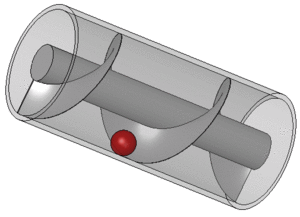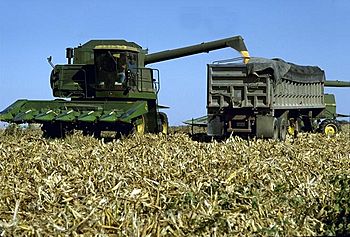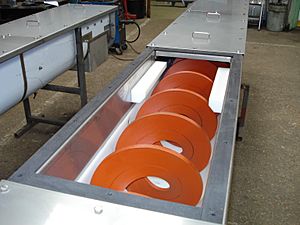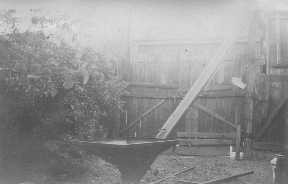Screw conveyor facts for kids

A screw conveyor is a machine that moves things using a spinning blade shaped like a corkscrew. This blade is often called a "flighting." It usually spins inside a tube or trough. Screw conveyors are great for moving liquids or small, loose materials like grains or powders.
These machines are used in many industries that handle large amounts of material. Modern screw conveyors often move materials horizontally or slightly uphill. They are a good way to move things like food waste, wood chips, cereal grains, animal feed, and even municipal solid waste. The very first screw conveyor was the Archimedes' screw, which people used long ago to pump water for farming.
Screw conveyors usually have a spiral blade wrapped around a central rod, called a shaft. This shaft is spun by a motor at one end. Some types have a "shaftless spiral" that spins freely at one end. The faster the shaft spins, the more material it moves. In factories, these machines can be used to add a very exact amount of material to a process by controlling how fast the screw turns.
Screw conveyors can also move materials upwards. If there's enough space, this is a cheap way to lift and move things. But, if the angle of going up gets too steep, the machine can't move as much material. The spinning part of the conveyor is sometimes just called an auger.
Contents
How Do Screw Conveyors Work?
Screw conveyors use a simple idea: a spinning spiral blade pushes material along. Imagine a corkscrew twisting into a bottle; it pulls the cork up. A screw conveyor does something similar, but it pushes loose materials.
Parts of a Screw Conveyor
- Screw Blade (Flighting): This is the spiral part that does the pushing. It can be made of different materials depending on what it's moving.
- Shaft: The central rod that the screw blade is wrapped around. It connects to the motor.
- Trough or Tube: This holds the material and keeps it moving in the right direction.
- Motor: This makes the shaft and blade spin.
Screw Conveyors in Farming

In farming, a "grain auger" is a very common type of screw conveyor. Farmers use it to move grain from trucks or grain carts into large storage bins. Later, gravity chutes at the bottom of the bins let the grain out.
Powering a Grain Auger
A grain auger can get its power from different sources:
- An electric motor.
- A tractor, using its power take-off (PTO) system.
- Sometimes, a small internal combustion engine right on the auger.
The spiral blade spins inside a long metal tube, lifting the grain. At the bottom, a hopper collects grain from the truck. At the top, a chute guides the grain into the storage bin.
Who Invented the Modern Grain Auger?
The modern grain auger used by farmers today was invented by Peter Pakosh. He designed a screw-type auger with very few moving parts, which was a new idea for this use. In the 1940s, Pakosh tried to share his idea with Massey Harris (a big farm equipment company). They told him his idea was bad and that the metal parts would cause fires!
But Pakosh didn't give up. He built his first working auger in 1945. Eight years later, he started selling thousands of them under the 'Versatile' brand. His design became the standard for modern grain augers.
Smaller Grain Augers
A special, smaller grain auger is used to fill seed drills. These are much shorter and thinner than the augers used for trucks. They are often called "drill fills." Very thin grain augers, no matter what they are used for, are sometimes called "pencil augers."
Centerless Augers in Animal Farming
Centerless augers are popular in large animal farms. They are mainly used to move animal feed from a big storage area to individual feeding stations. These augers are flexible, so they can move feed up, down, and around corners. The first centerless auger was patented by Eldon Hostetler and Chore-Time Equipment for this purpose.
Other Cool Uses for Screw Conveyors
Screw conveyors are used in many other machines and industries:
- Snowblowers: They move snow towards a spinning fan (impeller) that then throws the snow out of a chute.
- Combine Harvesters: These big farm machines use augers to move crops into the part that separates the grain, and also to move the clean grain into and out of the machine's storage tank.
- Ice Resurfacers: Machines that smooth ice rinks use augers to pick up loose ice bits from the surface.
- Injection Molding Machines: An auger is a key part of these machines, which make plastic parts.
- Rubbish Compactors: Some compactors use an auger to push rubbish into a plate to squeeze it down.
- Food Processing: Augers are great for moving powders and small food pieces. In a meat grinder, an auger pushes meat through a spinning blade and a holed plate to make ground meat or sausages. They also push food through special shapes to make pellets, like for bran flakes.
- Oil Fields: Augers move rock cuttings away from drilling sites.
- Pellet Stoves and Barbecue Grills: They move fuel (like wood pellets) from a storage bin into the fire in a controlled way.
- Machining: In metalworking, augers can move metal scraps (called swarf) away from the machine.
- Wastewater Treatment Plants: They help remove solid waste from the water cleaning process.
- Military Vehicles: The amphibious infantry fighting vehicle BMP-3 uses auger-like parts to help it move in water.
See also
 In Spanish: Transportador de tornillo para niños
In Spanish: Transportador de tornillo para niños



